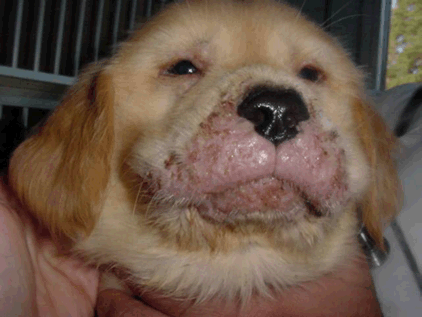
Puppy Heart Murmur
A heart murmur is a specific sound detected when listening to the heart with a stethoscope. This sound is a result of the blood flowing faster than normal within the heart itself or in one of the two major arteries leaving the heart (the aorta and pulmonary artery). Instead of the normal Lubb Dupp, an additional sound is present that can vary from a mild pshhh to a loud whoosh!

What is a heart murmur?
Your vet will use a stethoscope to listen to all areas of the heart
A heart murmur is a specific sound detected when listening to the heart with a stethoscope. This sound is a result of the blood flowing faster than normal within the heart itself or in one of the two major arteries leaving the heart (the aorta and pulmonary artery). Instead of the normal Lubb Dupp, an additional sound is present that can vary from a mild pshhh to a loud whoosh!
Your vet may use a grading system from 1 to 6 to describe how loud the murmur is e.g. a grade 1 murmur is very soft and a grade 6 murmur is very loud.
Heart murmurs in dogs can develop at any stage of their life. However, the significance of the heart murmur can be very different depending on the age at which the murmur is first detected.
My dog seems normal to me but my vet has detected a heart murmur. Is this possible?
It often comes as a surprise to owners to be told that their dog has a heart murmur. Many dogs with heart murmurs seem normal to their owners and have no obvious symptoms of heart disease. However, it is important to remember that the presence of a heart murmur is just an indication that there may be underlying heart disease. In itself the heart murmur is not a diagnosis. This is why further investigations such as x-rays, ECG or an ultrasound scan of the heart (also referred to as an echocardiogram or ‘echo’) may be required.
If your dog has had a heart murmur detected but is not showing symptoms of heart disease, it is possible that the heart disease may not yet have developed significantly enough to affect the normal functioning of the heart. However, this situation can change and cardiac symptoms can develop rapidly. By gaining as much information as possible about your dog’s heart, you and your veterinary surgeon will be in the best position to recognise early symptoms of heart disease should they occur. This is very important as it means that appropriate treatment to assist heart function can be started promptly if and when it is required.
Heart murmurs in puppies
Innocent ‘flow murmurs’ are the most common type of heart murmur detected in puppies. These disappear by 5 months of age
If a heart murmur is present from birth or develops shortly after birth, it will probably be detected by your veterinary surgeon at the first or second vaccinations. In puppies, there are two major types of heart murmurs. The most common type is called an innocent “flow murmur”. This type of murmur is soft (typically a grade 2 or softer) and is not caused by underlying heart disease. An innocent flow murmur typically disappears by 4-5 months of age.
However if a puppy has a loud murmur (grade 3 or louder), or if the heart murmur is still easily heard with a stethoscope after 4-5 months of age, the likelihood of an underlying congenital heart problem (i.e. heart disease that the puppy was born with) becomes much higher. Examples of congenital heart problems in dogs are patent ductus arteriosus, aortic stenosis and pulmonic stenosis. Interestingly, some types of congenital heart disease in puppies have very characteristic sounding heart murmurs.
The thought of your puppy having congenital heart disease is understandably extremely worrying, but it is important to remember that not all types of congenital heart disease will affect your puppy’s’ life expectancy and quality of life. If congenital heart disease is suspected, your vet will almost certainly want you to see a specialist for further assessment.
How to Identify and Treat Puppy Strangles Disease
This immune system disorder looks bad but is not fatal
Updated 01/30/19
Puppy strangles is a scary term for a condition of the skin more technically described as juvenile cellulitis or puppy pyoderma. While it’s not a common problem, it most frequently affects puppies younger than 12 weeks old. Puppy strangles is especially problematic in Labrador retrievers, golden retrievers, Brittany spaniels, springer spaniels, and dachshunds.

Signs
Puppy strangles is a result of an immune malfunction. The skin, especially on the face, becomes infected with deep sores. These sores can become so involved that they reach the lymph nodes of the neck. This neck area swells with hard knots under the jaw until it looks like the baby dog will strangle—hence the name.
Puppy pyoderma is characterized by pustules on the face, and painful swelling of the lips, eyelids, and face. This may also include swellings in the groin area, where the lymph glands are located. Infected neck lymph nodes often become abscessed, break open and drain.

Signs of puppy strangles go beyond the facial sores. Puppies develop a fever, become lethargic, and stop eating, which can lead to low blood sugar that complicates the condition.
Treatment
While puppy strangles generally aren’t life-threatening, they do need immediate veterinary care. The draining sores on the face must be diagnosed as pyoderma, as opposed to juvenile demodectic mange that looks similar. Treatment for puppy strangles such as steroids to relieve the inflammation could actually make the demodectic mange worse.
Once your veterinarian has diagnosed the condition, ask for tips on how to help your puppy heal. Some home treatment can relieve the discomfort, too.
Home Care
Apply hot packs to the sore face two or three times a day. Rinse a washcloth with water as hot as you can stand, wring out the excess, and hold against the pup’s swollen throat. Moist heat brings blood circulation to the area to help heal the wound more quickly and clean out the infection. Apply moist heat five minutes on, five minutes off, until the cloth has cooled, and then reapply.
The sores that develop on the puppy’s face usually burst and then crust over. That’s quite uncomfortable as well as unsightly and you can help your puppy feel better by keeping these areas clean. Soak with warm water at least once a day to soften the crusties, and then gently wipe them off. Follow up by washing the area with a 2.5 percent benzoyl peroxide cleanser that helps heal the sores.
For the lymph nodes that have abscessed, clean the spots three to four times a day with warm water on a cloth applied for five to 10 minutes at a time. As with any abscess, these spots will be very tender, so be gentle. Rough cleaning also could increase the chance that the area will scar.
Veterinary Treatment
Your vet may need to lance abscesses that have not opened on their own. Flushing out the deep wound can be accomplished using a syringe (without the needle) or even a turkey baster or squirt gun filled with an antiseptic solution like diluted Betadine. Once it’s cleaned out, you can keep it clean with the repeated use of the diluted Betadine or warmed Burrow’s Solution, an astringent solution you can get at the drugstore.
Cleanliness alone won’t cure puppy strangles. Typically, several weeks of antibiotics from your vet will be needed to resolve any deep infection and prevent secondary bacterial infections in the draining wounds. Your vet may also prescribe steroids to reduce the inflammation.